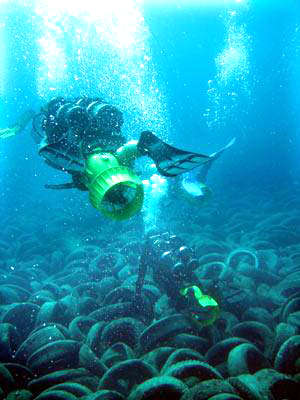Moving the clock forward an article from 2006 in the Miami Herald:
"Artificial reef made of tires becomes ecological disaster
What began 30 years ago as an idealistic plan to shape an artificial coral reef has become an underwater wasteland
BY TRENTON DANIEL

A plan in the early 1970s to create a massive artificial reef off Fort Lauderdale has turned into an environmental mess with the U.S. Navy, Broward County and others trying to figure out how to remove about two million tires covering 36 acres of ocean floor.
What was intended to lure game fish now is damaging sensitive coral reefs and littering Broward's tourist-populated shoreline.
''They thought it would be a good fish habitat. It turned out to be a bad idea,'' said William Nuckols, project coordinator and military liaison for Coastal America, a federal group involved in the cleanup. ``It's a coastal coral destruction machine.''
The tires dot the ocean bottom a mile and a half from the end of Sunrise Boulevard. Environmentalists say strong tides -- especially during hurricanes and tropical storms -- cause the loose tires to knock against coral reefs, disrupting the ecosystem. In some cases, tires have washed ashore.
Now, the U.S. Navy, Broward County and a few other groups are looking at a three-year plan to remove the tires. The organizers surveyed the waters last month.
''We're trying to work out all the specific details,'' Nuckols said.
Touted as the largest of its kind nationwide, the tire reef was created with the best of intentions.
In the spring of 1972, a nonprofit group called Broward Artificial Reef, or BARINC, hatched an idea to build a three-mile reef while at the same time disposing of old tires. The U.S. Army Corps of Engineers endorsed the project; similar ones had been created in the Northeast and Gulf of Mexico.
Broward County pitched in with the funds. BARINC even raised $8,000 from bingo games.
And so, the tires came from Goodyear and junkyards, bundled on barges to be dumped at sea. The idea was that an artificial reef -- called Osborne Reef -- would form from the stacked tires.
TIRES CAME LOOSE
But it didn't work.
Metal clips holding the tires together corroded, and the tires spilled across the ocean floor. Unlike sunken barges also used to build artificial reefs, the tires moved with the tide, and marine life never formed. Fishermen grumbled that game fish never came because the water there was too shallow.
''I do know we made a mistake in doing it,'' said Ray McAllister, one of BARINC's founders and now professor emeritus of ocean engineering at Florida Atlantic University. ``They weren't the great attractions we thought they would be.''
Today, the loose tires are damaging the environment because the tide tosses them about, causing them to bang against delicate marine life. The tires also emit a minortoxin, environmentalists say.
''I don't think anybody's worried about'' the toxin, said Todd Barber, chairman of the Reef Ball Foundation, an Atlanta not-for-profit organization that aims to protect reefs. ``The primary hazard [is] they're moving around.''
The cleanup comes after earlier efforts, including a study that resulted in picking up more than 1,000 tires. The first priority is to pull out the loose ones, because they are causing damage.
Broward County is coordinating the effort, which is expected to take about three years, said Ken Banks, a reef expert with the county's Department of Environmental Protection. The project is expected to begin in 2008 after a monthlong assessment next summer, Banks said.
The project's cost has not been determined, Banks said. Nuckols, of Coastal America, estimated it could reach $5 million. The state's environment department plans to fund the disposal or recycling of the tires, pending approval from the Legislature.
HELP FROM NAVY
The U.S. Navy could lend a crew of divers from its Mobile Diving and Salvage Unit 2 in Virginia, who will go 65 to 75 feet below the surface, pluck the tires and then load them on to a U.S. Army landing craft. The Navy divers stand to get real-life experience.
''They don't have to hire a professional salvage company, which is not going to be cheap,'' said Petty Officer Phil Beaufort, a U.S. Navy spokesman. ``This is an opportunity to get real training and do good.''
Florida's Department of Environmental Protection has expressed interest in the disposal or recycling of the tires once they reach the Port Everglades dock.
It's unlikely some of the tires could be recycled since many of them are encrusted with marine life such as sponges and barnacles, said Jan Rae Clark, environmental manager of the department's solid waste section. Those would most likely end up in a landfill.
Observers applaud the project.
''They've wanted to make a real concerted effort over some time,'' said Robin Sherman, associate professor at Nova Southeastern University. Ten years ago, Sherman stumbled across the tires while working on her doctoral dissertation. A few years later, she got a grant to study ways to clean them up, recruiting almost 90 diving volunteers and gathering 1,600 tires. The team recycled the tires, but became overwhelmed and abandoned the cleanup.
''I'm thrilled the project's going forward,'' Sherman said."
A video from Feb. 2010. You may want to turn the volume down, the sound track provides some audio pollution in its own right.
and you can hear an NPR report from 2007 at:
http://www.npr.org/templates/story/s...oryId=11462066
.